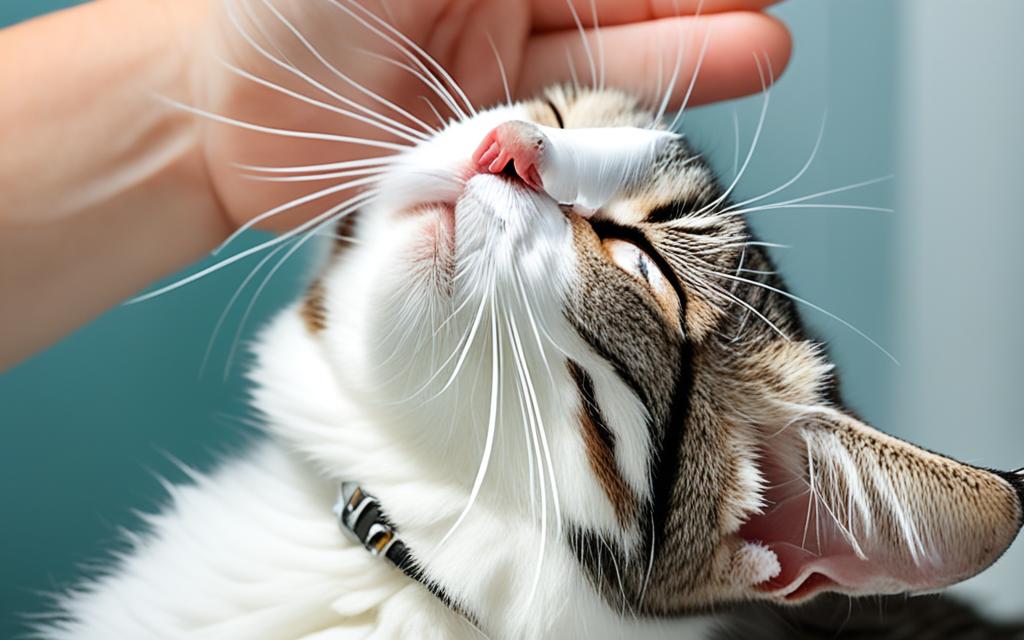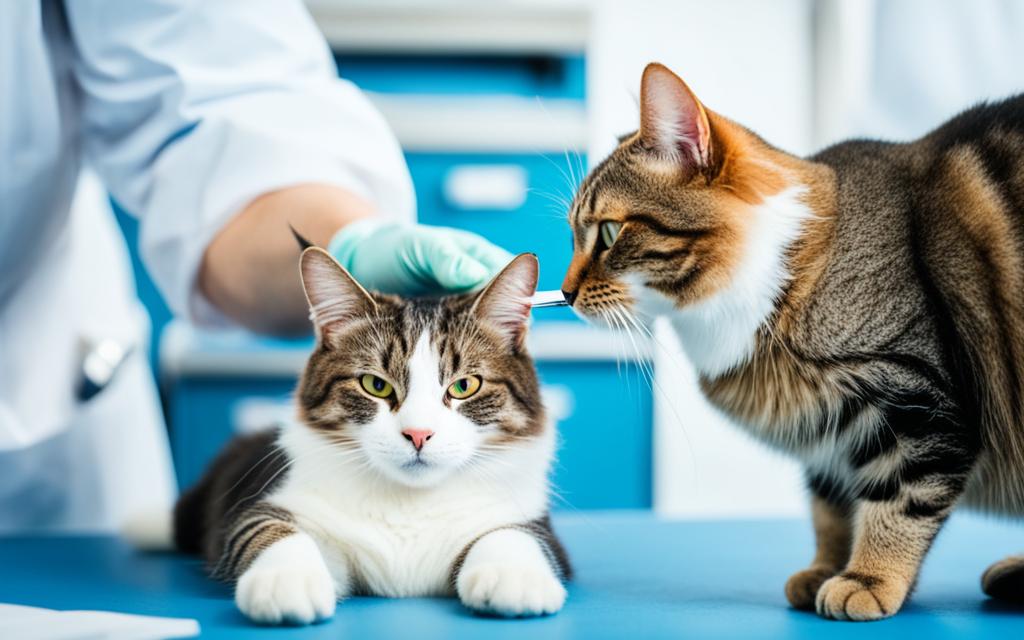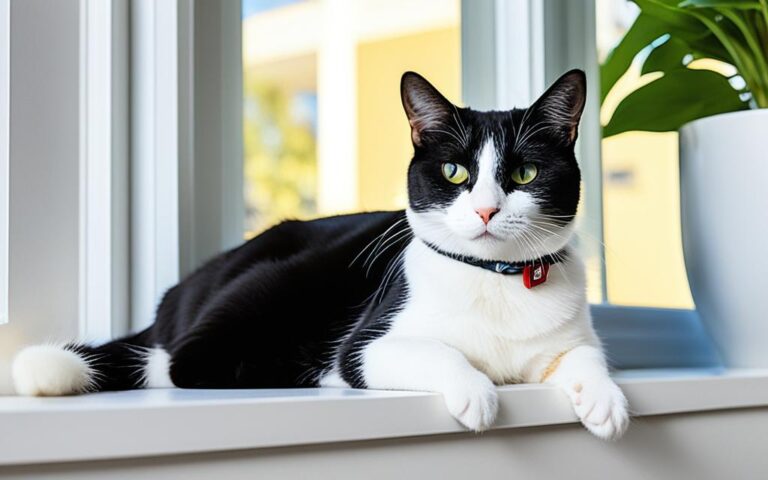Gentamicin for cats: Uses and Side Effects
Did you know a single antibiotic ointment can help fight many bacterial eye infections in cats, dogs, and rabbits1? This ointment is called Gentamicin. It’s a strong type of antibiotic that’s approved by the FDA for use in cats23.
In this guide, we’ll look at how Gentamicin helps treat cats, the forms it comes in, and what side effects it could have. Knowing about this medicine helps pet owners make smart choices for their cat’s health.
Key Takeaways
- Gentamicin is a prescription antibiotic used to treat bacterial infections in cats, dogs, and rabbits.
- It comes in various formulations, including topical ointments, eye drops, and injectable solutions.
- Gentamicin is effective against a wide range of gram-negative bacteria that can infect different parts of a cat’s body.
- Potential side effects include kidney damage, hearing loss, and muscle paralysis, highlighting the importance of veterinary guidance and proper dosing.
- Careful monitoring and storage are crucial when using Gentamicin to ensure safe and effective treatment for your feline companion.
Table of Contents
What is Gentamicin?
Gentamicin is a prescription antibiotic that the FDA has approved for use. It falls under the aminoglycoside drug category. You can find it in various forms, including sprays for the skin and ears like GentaVed®, eye drops like Gentocin® Durafilm®, and ointments. The ointments are good for skin and ear issues, such as GentaOtic™ and Otomax®. Sometimes, it’s mixed with other drugs like corticosteroids and antifungals4.
FDA Approval and Drug Classification
Gentamicin is OK’d by the FDA as an antibiotic for dogs and cats. It’s usually not just gentamicin alone; it often includes corticosteroids and antifungals5. As an aminoglycoside antibiotic, it stops bacteria from making proteins by messing with their DNA5.
Formulations and Brand Names
In dogs, gentamicin is mainly used for infections on the outer ear, the skin, and the eyes. For dogs, gentamicin is well-studied, but for other pets, not so much5. Some specialists might suggest custom-made drugs with gentamicin, which have not undergone FDA testing5.
Gentamicin is also beneficial for cats, especially for certain ear infections. Giving it to cats and dogs for ear problems is not what it’s mainly approved for4. You can apply it in the ears in the form of an ointment or drops. It’s also mixed with other ingredients to make specific ear drops for treating infections4.
“Gentamicin is an FDA-approved prescription antibiotic used to treat susceptible bacterial infections in dogs and cats.”
How Gentamicin Works
Mechanism of Action
Gentamicin is a strong antibiotic in the aminoglycoside class2. It works by attaching to the genetic code of certain bacteria. This stops the bacteria from creating proteins they need to live and reproduce2. In the end, the bacteria die, fighting off a wide variety of infections2.
This type of antibiotic is mainly used in hospitals by injection or drip3. It’s also common in vet medicine for tough infections. But, it can’t be used in pets with certain health issues, like liver or kidney disease2.
The way gentamicin works is especially good against some bacteria types2. It’s very helpful when other antibiotics might not work well2. By stopping the bacteria from making proteins, gentamicin quickly fights off the infection and helps the pet get better2.

“Aminoglycoside antibiotics, like gentamicin, work by binding to the bacterial ribosome and interfering with protein synthesis, leading to cell death.”
In the end, gentamicin is key because of how it works and its power against many bacteria2. But, its use needs close watching to prevent any bad effects326.
Gentamicin for cats: Uses and Side Effects
Gentamicin is an antibiotic mainly for dogs but can be used in cats by a specialized vet7. It’s often used to fight bacterial infections in the skin, eyes, and ears7.
One form used in pets is called Gentamicin Sulfate Ophthalmic Solution. It’s a sterile eye drop of 0.3% strength7. Pets like cats, dogs, and horses can have 1-2 drops every four hours as needed7. Each milliliter of this solution has 3 milligrams of gentamicin7.
Side effects from using this medication on cats can include eye and ear issues, and in some cases, signs from the stomach. Hearing loss, ear pain, and a tilting head may also happen7. Most times, serious side effects aren’t common, but close vet care is needed7.
There’s also a product for ear infections called Gentamicin Sulfate with Betamethasone Valerate Otic Solution8. This is for ear problems in both dogs and cats that need gentamicin to get better8. Safety tests show that at up to 10 mg/kg/day for 40 days, cats didn’t have bad effects8.
If your cat is on gentamicin, always follow the vet’s suggestions. Give it exactly as told and watch for any bad signs7. If a dose is missed, give it when you remember. Always call the vet if you think your cat ate some of the medicine7.
In summary, while gentamicin is not the first choice for cat care, some vets may choose to use it in specific cases7. It is vital to listen to the vet and watch your cat closely during treatment718.
Administering Gentamicin to Cats
When it comes to treating cats with gentamicin, doing it right is very important8. Your vet will decide how much gentamicin your cat needs, and how often, based on what they are treating9. Usually, cats get 3 to 4 mg per pound each day. This is about 5 to 8 mg for every kilogram. It’s given through the skin, into the muscle, or in a vein2.
Dosage and Frequency
You must carefully follow what your vet tells you about using gentamicin. The amount and how often your cat will get it can change. This depends on the infection’s seriousness and how well your cat responds to the medicine9. Normally, cats get it once a day, but this might change if needed9.
Directions for Use
If your cat is getting gentamicin in their eyes or ears, stick to the directions very closely. Apply them without getting the medicine in the eyes, mouth, or nose8. Use gloves to stop the medicine from spreading bacteria to you. Eye medicine should be used only after a check-up. This is important because using it in a deep eye wound can be bad for your cat’s eyes8. Eardrops need the same care, and they should not be used if your cat’s eardrum is hurt8.
For injections, like SQ, IM, or IV gentamicin, do exactly as your vet says9. This way, your cat will get the correct treatment according to the plan9.

“Proper administration is key to ensuring the safe and effective use of gentamicin in cats.”
Following the exact dose and how often your cat gets gentamicin, plus using it right, is crucial for a good treatment outcome892.
Potential Side Effects and Precautions
Gentamicin is usually safe, but it’s wise for cat parents to know the risks10. Older adults and tiny babies might face severe issues like damaged kidneys and hearing loss10. People with health conditions such as kidney problems or nerve damage have a higher risk of side effects from gentamicin10.
If your cat needs sprays or drops with gentamicin, be cautious. Some contain corticosteroids that can bring on changes in your cat’s body like more thirst or hair loss11. Eye drops with gentamicin might make the eyes burn or look red. Ear drops could cause slight redness in the ears or, in rare cases, problems with eating or a tilt of the head11.
Your cat should never take gentamicin if they’ve had a bad reaction before11. This medicine can sometimes affect the ears and balance. It could even cause blood in the urine or trouble breathing10. Nerve issues are another rare but possible side effect. These could appear as numbness or muscle twitches10.
Keep a close watch on your cat if they’re on gentamicin. Vets should run tests to spot any problems early10. Always follow your vet’s advice and tell them about any strange signs you notice11.
“Gentamicin can be a valuable medication for treating certain infections in cats, but it’s important to be aware of the potential side effects and to closely monitor your pet during treatment.”
| Potential Side Effects of Gentamicin in Cats | Mitigation Strategies |
|---|---|
| Kidney damage, hearing impairment | Careful monitoring, dose adjustments for elderly or infants |
| Increased thirst, urination, appetite, skin changes | Monitor for steroid-related side effects with topical/ear formulations |
| Eye irritation, ear redness, gastrointestinal issues | Closely observe for local/systemic reactions, report concerns |
| Nerve problems, numbness, muscle twitching | Regular testing to detect any neurological complications |
| Allergic reactions, including anaphylaxis | Avoid use in pets with known hypersensitivity |
By understanding the potential gentamicin side effects in cats and following the necessary precautions when using gentamicin in cats, pet owners can help ensure the safe and effective use of this medication for their feline companions101112.
Monitoring and Storage Guidelines
When giving gentamicin to cats, the vet might not need to check regularly13. But, they might still want to keep an eye on how the cat is doing. This makes sure the medicine is doing its job13. Before stopping the treatment, the cat must have a final check to make sure the infection is gone13.
Storing gentamicin right is very important for it to work well and be safe. Keep it in the original container at room temperature, between 59-86°F. Make sure it’s away from light and moisture13. If it’s a special mix, follow the pharmacy’s advice on how to store it13. Always keep gentamicin where kids and pets can’t get to it13.
| Monitoring Recommendations | Storage Requirements |
|---|---|
| Veterinarian may monitor cat’s response to ensure medication is working Cat should be rechecked before treatment is discontinue | Store in original container at room temperature (59-86°F) Protect from light and moisture Compounded formulas follow pharmacy instructions Keep out of reach of children and pets |
Watch and store gentamicin well to make sure cats are safe and get better13. By doing this, both pet owners and vets can make the most out of gentamicin. This reduces any dangers13.
Comparison with Other Antibiotics
Gentamicin is a popular antibiotic in cat care. But, comparing it to other antibiotics is key. We look at how well it works, what it costs, and any side effects it might have14.
Efficacy and Cost
Gentamicin does a bit better than amikacin against specific infections. These include issues like urinary tract infections and pneumonia. Still, both drugs, part of the aminoglycosides group, can harm the kidneys and ears when used for many types of illness15.
When it comes to pricing, gentamicin’s cost varies by type, if it’s a brand or not, and the usage. It’s often given with other antibiotics to tackle certain health problems15.
Side Effect Profile
Gentamicin has shown to affect the kidneys more than amikacin in cats15. In a test with guinea pigs, it was also harsher on the ears. Both drugs can cause ear harm starting at about the same time14.
| Antibiotic | Cumulative Dose for Impairment | Histological Renal Changes | Cochlear Dysfunction |
|---|---|---|---|
| Amikacin | Approximately 3,600 mg/kg | Less frequent than gentamicin | Moderate |
| Gentamicin | Approximately 700 mg/kg | More frequent than amikacin | More significant |
Using gentamicin and amikacin to treat animals is common but should be done carefully. Their use requires close supervision to prevent major health issues15.
Always talk to a vet to pick the best antibiotic for your cat. They will consider the cat’s health to make the right choice16.
“Infections must be treated with exact doses and treatment lengths as non-certified antibiotics may have different effects.”
Missed Dose and Overdose Information
Missed a dose of topical gentamicin for your pet? Apply it once remembered17. But, if near the next dose time, skip. This prevents extra doses and problems17. Always finish the full dose, even if your pet feels better. It stops future infections from becoming resistant to this and similar medicines17.
An overdose is rare unless a pet eats the medicine17. If you think your pet has had too much, act fast. Get emergency vet help, call 911, or reach out to a poison control center at 800-222-122217.
When giving gentamicin to cats, listen to the vet’s advice18. Store it right and act quickly if a dose is missed or in an overdose case. This ensures the medicine works well and is safe for your pet1819.
FAQ
What is Gentamicin?
How does Gentamicin work?
What are the uses of Gentamicin in cats?
What are the potential side effects of Gentamicin in cats?
How should Gentamicin be administered to cats?
How should Gentamicin be stored?
How does Gentamicin compare to other antibiotics?
What should I do if I miss a dose of Gentamicin or suspect an overdose?
Source Links
- Gentamicin Sulfate Eye Ointment
- Gentamicin (Gentocin®) for Dogs and Cats
- Gentamicin in Veterinary Medicine – Facts and Information | PetCoach
- Gentamicin – Otic | VCA Animal Hospitals
- Gentamicin for Dogs and Cats
- Gentamicin Sulfate Eye Drops
- Gentamicin Sulfate Ophthalmic Solution 5 ml | 1800PetMeds
- Gentamicin-betamethasone Otic solution for Animal Use – Drugs.com
- Gentamicin for Animals – Dog, Cat, Cattle, Horse, Pig, Sheep, Goat
- Gentamicin (Injection Route) Side Effects
- No title found
- Comparative Ototoxicity of Amikacin and Gentamicin in Cats
- Comparative Antimicrobial Activity of Amikacin and Gentamicin on Clinically Important Bacteria
- Common Antibiotics for Dogs and Cats
- Gentamicin topical: Uses, Side Effects, Interactions, Pictures, Warnings & Dosing – WebMD
- Gentamicin (Ophthalmic Route)
- Betamethasone Gentamicin Topical | VCA Animal Hospitals







